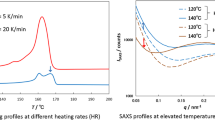Abstract
The effect of high pressure on the higher-order structures of poly(oxyethylene) (PEG) crystallites in poly(d,l-lactide)/poly(oxyethylene) (PDLLA/PEG) blends during melting and recrystallization was investigated by in situ small-angle X-ray scattering (SAXS) measurements. It was found that melting temperature (T m) increases at 50 MPa in accordance with the prediction by the Clausius–Clapeyron equation. However, T m at slightly pressurized state (5 MPa) surprisingly decreased, suggesting that the effect of pressure is not so straightforward. It may be due to an increase of the miscibility under higher pressure, causing the melting point depression. Meanwhile, an advantage of analyses of SAXS data enabled us to determine directly discrete distribution of lamellar thickness as a function of temperature under pressure. As a result, lamellar thickening was observed at 5 and 50 MPa as temperature approaches closer to the melting point, but the tendency of thickening was lesser as compared to that observed at ambient pressure.
Graphical abstract







Similar content being viewed by others
References
Auras R, Harte B, Selke S (2004) An overview of Polylactides as packaging materials. Macromol Biosci 4(9):835–864. doi:10.1002/mabi.200400043
Tsuji H (2005) Polylactides. In: Biopolymers Online. Wiley-VCH Verlag GmbH & Co. KGaA. doi:10.1002/3527600035.bpol4005
Tsuji H (2005) Poly(lactide) stereocomplexes: formation, structure, properties, degradation, and applications. Macromol Biosci 5(7):569–597. doi:10.1002/mabi.200500062
Gupta B, Revagade N, Jn Hilborn (2007) Poly(lactic acid) fiber: an overview. Prog Polym Sci 32(4):455–482. doi:10.1016/j.progpolymsci.2007.01.005
Inkinen S, Hakkarainen M, Albertsson A-C, Södergård A (2011) From lactic acid to poly(lactic acid) (PLA): characterization and analysis of PLA and its precursors. Biomacromolecules 12(3):523–532. doi:10.1021/bm101302t
Hagen R (2012) 10.12—Polylactic acid. In: Krzysztof M, Martin ML (eds) Polymer science: A comprehensive reference. Elsevier, Amsterdam, pp 231–236. doi:10.1016/B978-0-444-53349-4.00269-7
Tien N-D, Hoa T-P, Mochizuki M, Saijo K, Hasegawa H, Sasaki S, Sakurai S (2013) Higher-order crystalline structures of poly(oxyethylene) in poly(d, l-lactide)/poly(oxyethylene) blends. Polymer 54(17):4653–4659. doi:10.1016/j.polymer.2013.06.028
Tien N-D, Sasaki S, Masunaga H, Shimizu N, Igarashi N, Sakurai S (2014) Small-angle X-ray scattering studies on melting and recrystallization behaviors of poly(oxyethylene) crystallites in poly(d, l-lactide)/poly(oxyethylene) blends. Polymer 55(10):2562–2569. doi:10.1016/j.polymer.2014.03.048
Nakafuku C (1994) High pressure crystallization of poly(L-lactic acid) in a binary mixture with poly(ethylene oxide). Polym J 26(6):680–687
Janssen S, Schwahn D, Mortensen K, Springer T (1993) Pressure dependence of the Flory-Huggins interaction parameter in polymer blends: a SANS study and a comparison to the Flory-Orwoll-Vrij equation of state. Macromolecules 26(21):5587–5591. doi:10.1021/ma00073a009
Hammouda B, Balsara NP, Lefebvre AA (1997) Small-angle neutron scattering from pressurized polyethylbutylene/polymethylbutylene blends. Macromolecules 30(18):5572–5574. doi:10.1021/ma970673a
Frielinghaus H, Schwahn D, Willner L (2001) Blends of polybutadiene with different vinyl contents and polystyrene studied with small-angle neutron scattering in varying temperature and pressure fields. Macromolecules 34(6):1751–1763. doi:10.1021/ma001015k
Frielinghaus H, Schwahn D, Dudowicz J, Freed KF, Foreman KW (2001) Small-angle neutron scattering studies of polybutadiene/polystyrene blends as a function of pressure and microstructure: comparison of experiment and theory. J Chem Phys 114(11):5016–5025
Schwahn D, Frielinghaus H, Mortensen K, Almdal K (2001) Abnormal pressure dependence of the phase boundaries in PEE, àíPDMS and PEP, àíPDMS binary homopolymer blends and diblock copolymers. Macromolecules 34(6):1694–1706. doi:10.1021/ma0002545
Frielinghaus H, Schwahn D, Willner L, Freed KF (2002) Small angle neutron scattering studies of a polybutadiene/polystyrene blend with small additions of ortho-dichloro-benzene for varying temperatures and pressures. II. Phase boundaries and Flory-Huggins parameter. J Chem Phys 116(5):2241–2250
Clausius R (1850) Ueber die bewegende Kraft der Wärme und die Gesetze, welche sich daraus für die Wärmelehre selbst ableiten lassen. Ann Phys 155(4):500–524. doi:10.1002/andp.18501550403
Simon FT, Rutherford JM (1964) Crystallization and melting behavior of polyethylene oxide copolymers. J Appl Phys 35(1):82–86
Fox TG (1956) Influence of diluent and of copolymer composition on the glass temperature of a polymer system. Bulletin of the American Physical Society 1:123
Questad DL, Pae KD, Newman BA, Scheinbeim JI (1980) Pressure dependence of the glass transition and related properties of Solithane 113 elastomer. J Appl Phys 51(10):5100–5105
Acknowledgments
This study was partially supported by Grant-in-Aid for Scientific Research on Innovative Areas “New Polymeric Materials Based on Element-Blocks” (No. 25102524) from the Ministry of Education, Culture, Sports, Science, and Technology of Japan. The SAXS experiments were performed under the approval of the SPring-8 Program Advisory Committee (Proposal No.: 2010B1109).
Author information
Authors and Affiliations
Corresponding authors
Rights and permissions
About this article
Cite this article
Tien, ND., Sasaki, S. & Sakurai, S. Influence of high pressure on higher-order structures of poly(oxyethylene) in its blend with poly(d,l-lactide). Polym. Bull. 73, 399–408 (2016). https://doi.org/10.1007/s00289-015-1496-z
Received:
Revised:
Accepted:
Published:
Issue Date:
DOI: https://doi.org/10.1007/s00289-015-1496-z



